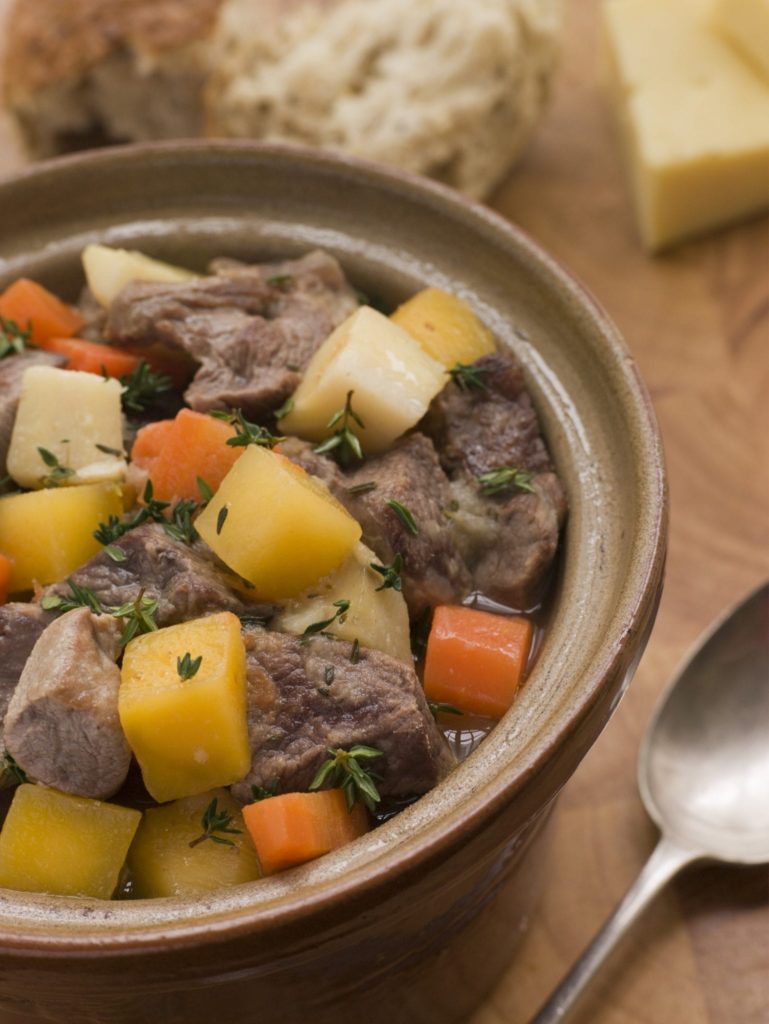So, we’ve established that to heal your skin, you’re first going to have to heal your gut.
And what’s the fastest way to do this?
It’s a happy one-two combo of kefir and something I like to call collagen broth. Collagen broth is essentially the same thing as meat stock or bone broth. The traditional Welsh version of this meat stew is called “cawl.”
The idea here is:
- Heal the lining of the gut with collagen broth
- Re-populate your newly healed gut with the good bugs in kefir.
I discovered the real power of collagen broth the way that I’ve discovered most things – by accident, out of necessity, on the farm!
The way it happened was this: As I mentioned earlier, our farm is nearly self-sustaining. (Not completely – we do buy loads of things from the outside world!) But we make as much as we can ourselves. Firstly because it’s clean, and free of chemicals. And then because – well, we enjoy it! Nothing quite so satisfying as things you make yourself.
So, we raise a lot of our own meat animals. Our own lamb, for example, gets butchered, dated, tagged, wrapped in plastic and placed into our big freezers.
When I first came to the farm and was trying to work everything out, I was a bit boggled by this array of large hunks of frozen beast, sitting mysteriously in the freezer. Too big to fit into a regular sauce pan, too frozen to cut.
“What am I supposed to do with this?” I asked Rich plaintively.
He looked at me as if I was crazy. Really he was very patient, teaching a city girl all the things she needed to know.
“Chuck it into some water and make cawl with it,” he said, as if it was obvious.
What the heck was cawl? I wondered. I sneaked off into a corner with my copy of the Complete Farmhouse Cookbook, (which is more than 100 years old and falling apart at the seams) and frantically looked up “cawl.”
Cawl, it turns out, is a traditional Welsh stew. Because the Welsh are thrifty farm folk, they boiled the meat and vegetables together for the flavour and stock, and then would serve the vegetables first ( to blunt the appetite) and then the tasty bits of meat afterwards. But these days it just gets eaten in one happy big bowl! If you come to Wales, you’ll see cawl on the menus of many restaurants and pubs. It’s most often made with good Welsh lamb, but technically can be any type of meat.
Cawl is best on its second boil – in the olden days, the soup pot would just be kept going continuously, with new bits of meat tossed in, and more potatoes added if company came round!
There’s a great story about a shooting lodge where they kept a big continuous pot of cawl simmering through the entire shooting season. The cawl just kept getting better and better, and all the guests raved about the amazing flavour.
At the end of the season the big iron pot was up-ended to be scrubbed and put away – and at the bottom they found one woollen shooting sock, that had been boiling away the whole time! It must have been airing over the range, and fallen in by mistake. The cooks never told the secret to the guests, but legend has it that the cawl was never quite so tasty again! ; )
Now, I don’t go quite that far. But these days I do nearly always have a large pot simmering away in the farmhouse kitchen now. Once I understood the beauty of collagen broth, I became one of its greatest advocates. I sip a mug of warm broth first thing in the morning, with a bit of sea salt and lemon. It’s soothing, nourishing, filling, and gets my day off to a great start.
The real secret of cawl – or collagen broth – is that is stock that is made with bones. Our ancestors cooked with bones – they wasted nothing! Eat the meat, then turn the scraps and bones into nourishing stews.
These days, of course, everything is packaged for convenience. And because we buy everything by weight, from the supermarket, it’s rare to buy meat with the bones still in it. So we don’t tend to do anything with bones.
Funny thing is, the decrease in traditional practices like “cooking with bones” happened at the same time that we’ve seen an epidemic-style increase in things like eczema – which is up more than 40% since 2005 alone! 1 Coincidence? Maybe…or maybe just one more sign of the traditional ways we used to live, slipping by the wayside, and leaving us less healthy in their absence.
The real power in collagen broth is that the tendons, joints and ligaments, when cooked down, supply collagen in a bio-available form that’s easily accessed and used by your system. This is the stuff that heals the lining of the gut.
Also – and here’s a side benefit – collagen is the holy grail of beauty. For glowing skin, hair and nails, your body needs it. And after age 40, your body no longer produces it! So a cup of collagen broth every day will put this amazing stuff back into your body, where it can work its magic.
The best book I’ve found on this topic (and the most fun to read!) is called the Bone Broth Secret: A Culinary Adventure in Health, Beauty, Longevity by Louise Hay and Heather Dane. This book has loads of interesting science and great recipes.
Louise Hay is the original author of You Can Heal Your Life, the phenomenally successful visualisation and self-help book published back in the 80’s that basically kick-started the entire human potential movement. Now in her 90’s and still beautiful, vibrant and active, Louise Hay is a real-world inspiration for anyone who wants to heal themselves. Talk about walking your talk! Whatever she has for breakfast is what I want to have! (Note – it’s bone broth…no surprises there! ; )
Anyhow, the Bone Broth Secret explains it this way: “Collagen is the body’s most abundant protein. While it’s often referred to as connective tissue, we like to think of collagen as “the great supporter”. It supports, strengthens, cushions, provides structure and holds the body together. Collagen makes up bones, teeth, tendons, ligaments, joints and cartilage; and is key for beautiful hair, skin and nails. It strengthens muscles, aids cells growth, and supports the hollow organs of your digestive system – esophagus, stomach and small and large intestine….Bone broth denatures collagen into an easily digestible form called gelatin. And gelatin protect the intestines by lining the mucous membrane and defending against any further issues from food or drink, which makes it a valuable option for improving digestive problems.”
Louise and Heather make a distinction between bone broth, which uses only bones and is simmered for up to 24 – 48 hours or more, and meat broth, which leaves meat on the bones, and is simmered for around three hours.
Cawl is more similar to meat broth, as the bones we use generally always have meat on them. Bone broth is stronger as it has more glutamates, which are nonessential amino acids with many health benefits for your gut. I call mine collagen broth, as it’s got small amounts of meat on the bones, and simmers for an intermediate length of time – longer than meat stock, shorter than bone broth – about 9 hours. If you put it on first thing in the morning, before you leave for work, and have it for supper that night, it should be just about right. (A little longer or shorter is fine – collagen broth is forgiving stuff!)
If your gut health is compromised, Louise and Heather advise that consuming too many glutamates (as in bone broth) right away might tip you into a detox state. So I recommend starting out with collagen broth, and moving onto bone broth later on if you choose, as your gut health improves.
Here’s how to make collagen broth (and cawl):
If you have roast on Sunday (which we nearly always do, on the farm) then you just chuck all the bones and meat leftovers from the main carcass into a big saucepan. (We don’t use the scraps from people’s plates, we give those straight to the cats.)
My stock pot is a whopping 20 L, but then I have a big family! Still, collagen broth is such a brilliant thing that I’m going to encourage you to make extra and freeze a bunch of it – so at least a 10 L stock pot is a good thing to have on hand, no matter how many people you generally feed.
So, after a nice roast dinner on Sunday, on Monday morning the meat carcass leftovers go into the big stock pot and start simmering away. It simmers all day, filling the house with the most mouth-watering scent. I defy anyone to take a breath of simmering broth and fail to be transported to a happy, comforted place in their head.
Collagen broth simmers all day. The magic of is bones+water+time. If you’re at work during the day, treat yourself to a slow cooker, and simmer it all day in that. Just put in enough water that the pan won’t go dry. The smell will uplift you when you come through the door at the end of the day, and give you strength to put together the rest of the supper!
Once it’s been simmering all day, sieve out the meat and bones from the broth. Here’s how I do that – I have two big pans, and one big colander, which fits inside the pans. Strain the broth by tipping it from one pan into a colander-which-is-sitting-inside-the-second-pan. The colander will catch all the meat and bones, while the broth goes into the pan beneath it.
Then you put the broth pan back onto the heat to continue simmering. Put the meat and bones (sitting in a pan to catch the drips) to one side to allow the whole thing to cool enough to handle.
Put your veg into the simmering broth pan at this point. I use carrots, swede, potatoes, onions. Use whatever vegetables you have on hand, and that your family likes.
If you’re starting from scratch, think two carrots and five new potatoes per person that you’re feeding, plus one onion and one swede for the pot. All veg can be chopped quite roughly, in big pieces – this is a hearty peasant-style stew! The vegetables can simmer in the broth for about an hour.
Once the meat and bones have cooled enough to handle comfortably, pick the meat off the bones. Add it back into the cawl 15 minutes before serving.
You can re-use bones for broth at least twice before discarding them – just pop them into the freezer until you’re ready to make cawl again. (Once we’ve gotten all the goodness out of the bones, ours go to the barn cats, they think they’ve gone to kitty heaven!)
At this point I usually tip off some of the broth-only into a separate pan, which I store in the fridge for up to three days. I ladle some broth into a mug and heat it up to drink separately, at least once a day.
You can also freeze the broth in giant silicon ice-cube trays, (they make them for freezing baby food, you can get them with lids) and pop out one at a time to thaw, if you make more broth than you can get through in three days.
In the meantime, it’s cawl for supper! To have the traditional Welsh cawl, chop up a leek and toss it in, along with the cooled meat, 15 minutes before you’re ready to serve. Season to taste with sea salt and black pepper.
Enjoy! ; )

















